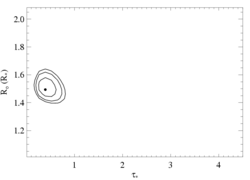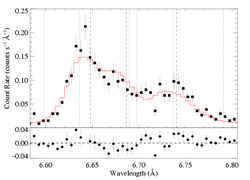Si XIII 6.6479, 6.6866, 6.7403 Angstroms
Non-porous models
Note: Both MEG and HEG are being fit simultaneously. See the fitting log. We used the hewind model, which fits the three components with separate wind profile models in which the relevant parameters are tied together, including the radius-dependent relative emissivities of the forbidden and intercombination lines. In other words, the line ratios and line shapes are self-consistently accounted for.
Continuum fit on 6.40:6.55 and 6.82:6.95. View the spectral region near the line: MEG and HEG. For n=2, best-fit norm=9.26e-4. The 68% confidence limits on the normalization are +/- 0.5e-4. And the best fit is formally a good fit (though not as good as usual; see the fitting log linked above; we tried several different continuum fits). We used a value of phiratio = 17.8 for the fit reported below.
Here are the 68%, 90%, and 95% joint confidence limits on taustar and uo. The filled circle represents the best-fit model, shown as the red histograms on the above plots.

|
We fit porous models to this line complex but found that the porosity length was very poorly constrained; basically unconstrained.
Back to main page.
last modified: 5 January 2009

